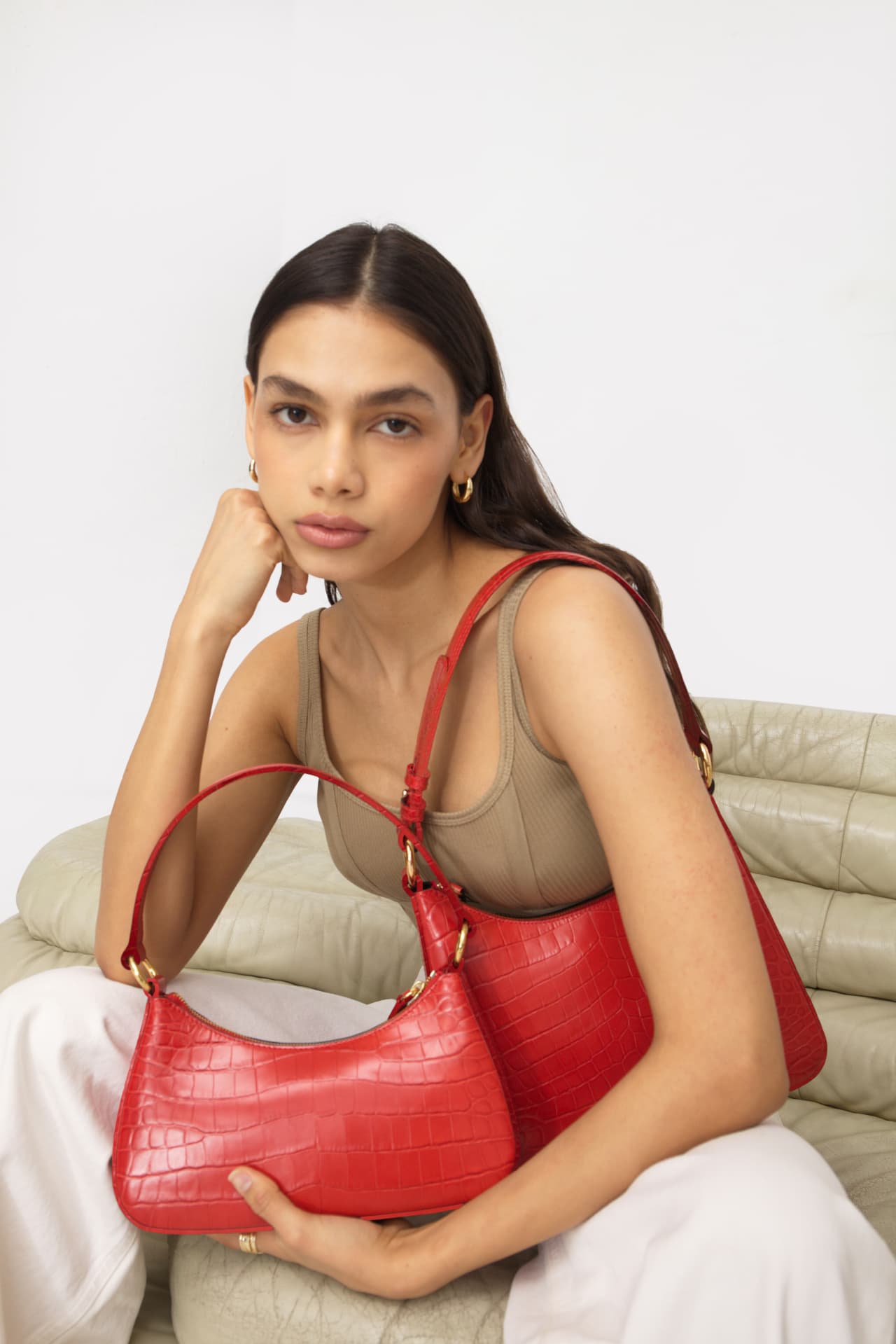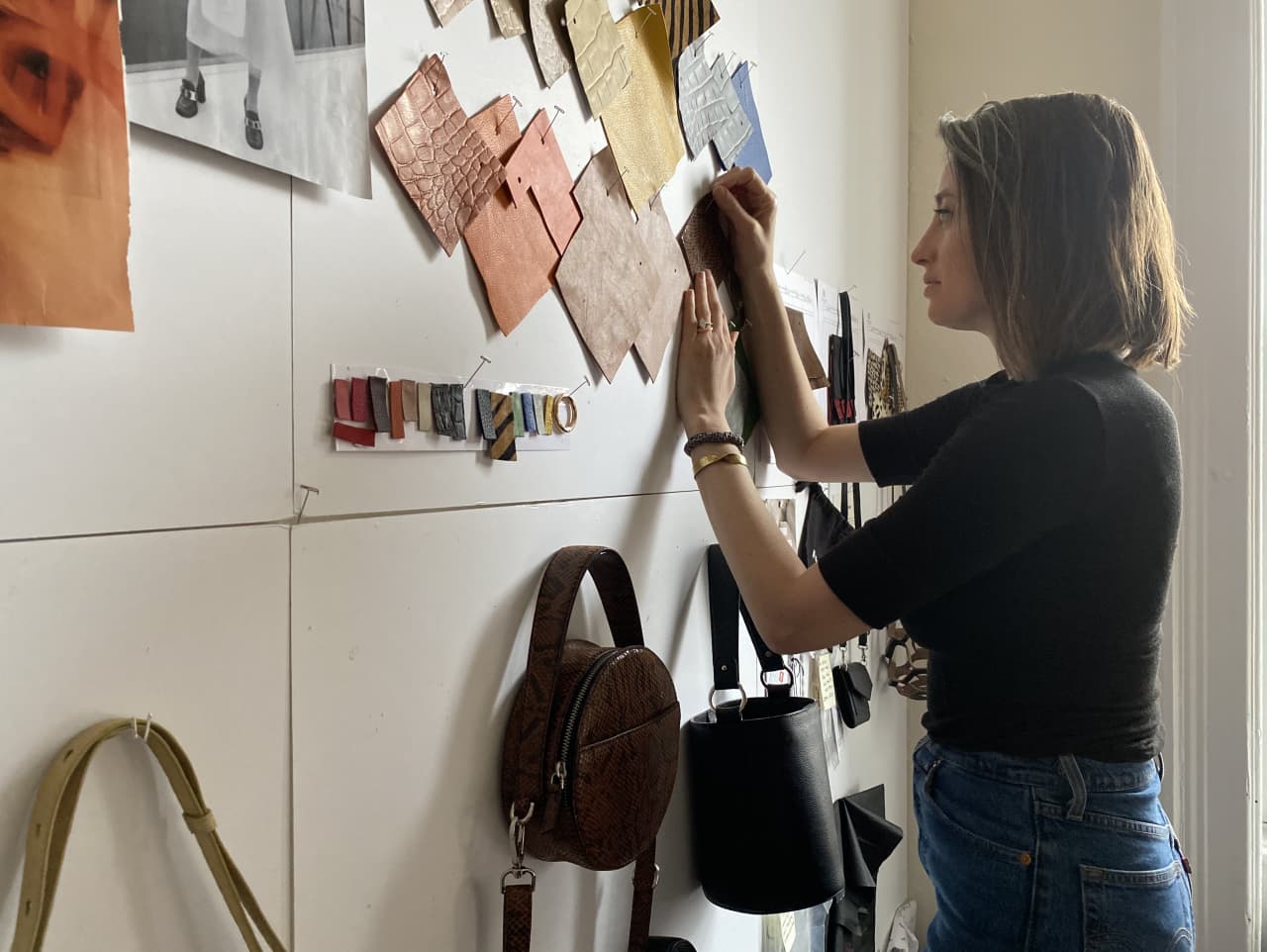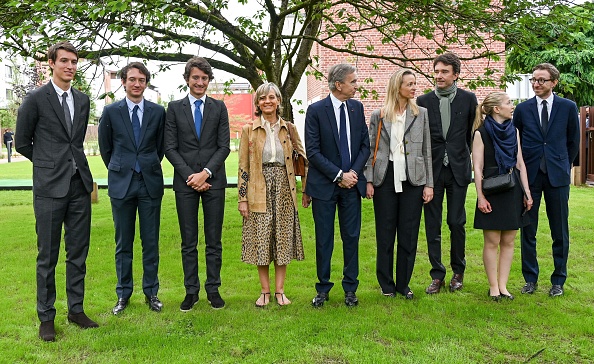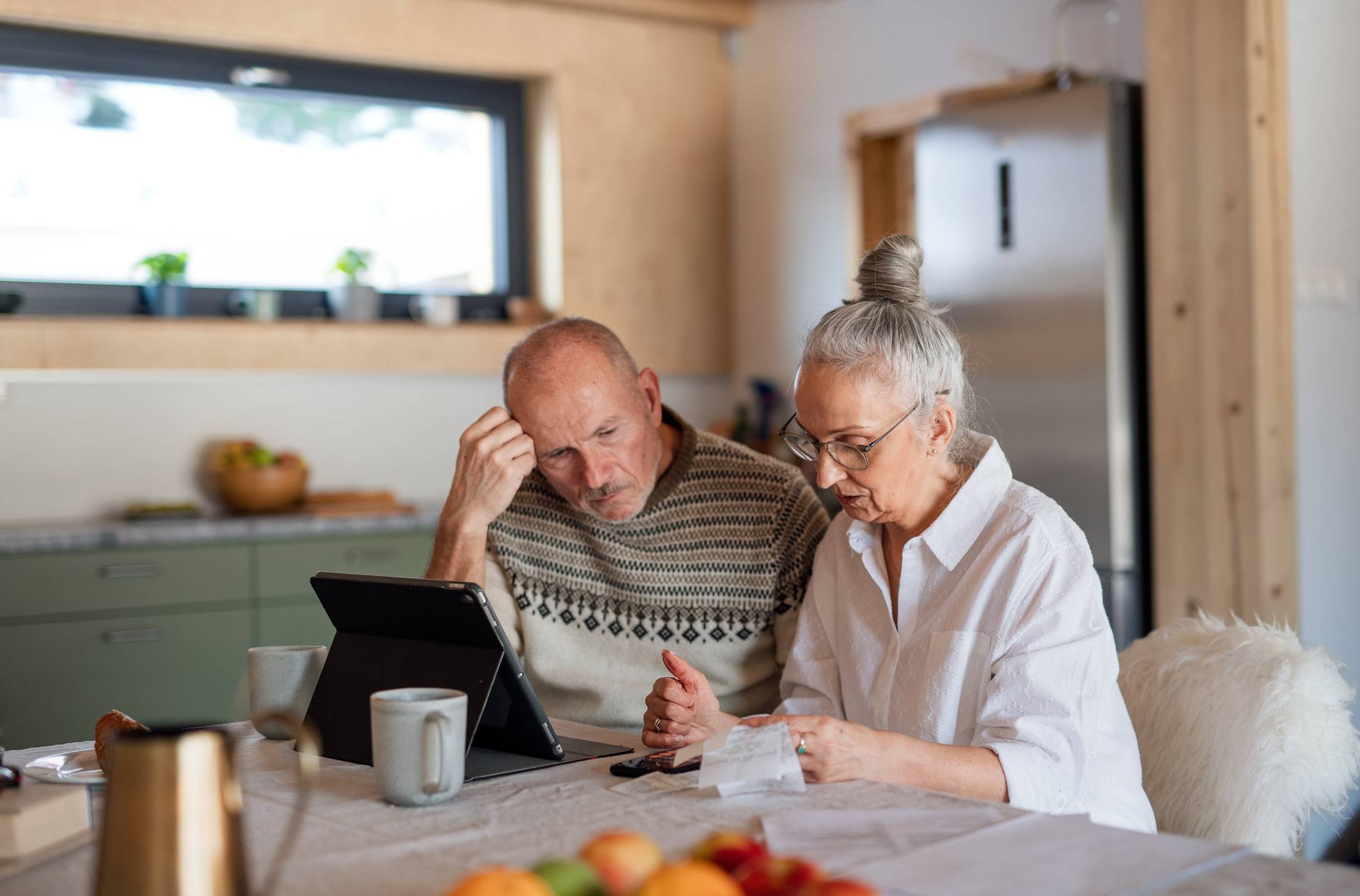Taking on Fast Fashion With Leather Bags Made From Luxury Brand Scraps
Dana Cohen witnessed the meteoric, and frightening, rise of fast fashion working for apparel companies in New York City for over a decade.
“We went from designing unique, thoughtful products to chasing trends and everything started to look the same,” recalls Cohen, 41, who was born and raised in Florida but now lives in Brooklyn with her family. “I watched fabrics get ordered and never be used and garments piling up on sales racks. We were drowning in fashion excess.”
It was then Cohen realised that she could do something to help while remaining in an industry she loved. “I couldn’t be complicit in the destruction of the planet and knew there had to be a better way to design,” she says.
undefined In November 2019, just a few months before the pandemic, Cohen launched Hyer Goods, a leather accessories company that uses the waste created by other brands—with fabric sourced from deadstock and factory scraps—to make bags, wallets, keychains, and blazers. The name Hyer is a riff on “higher,” or better, design.
Cohen’s mission is simple: to use scrap waste and “turn it into something beautiful.”
THE ITEMS
Hyer Goods focuses on leather because it is “high-quality, durable and can last for generations. The last thing we’d want to do is create more things that just end up in a landfill,” Cohen says. She launched an accessories brand, meanwhile, because accessories are small. “Focusing on small goods enables us to maximise the waste available. We even use the cutting waste to make our small leather goods, like card wallets and watch bands.”
Items include the ’90s-style luxe medium shoulder bag, which comes in colours like white and bright red and crocodile texture. There is also the luxe camera bag—available in a bright pop of fuschia pink and more neutral tones, such as camel—and the pocket cube bag, an everyday satchel with a canvas front pocket.
Hyer Goods also sells a deadstock leather blazer in a relaxed fit in black, chocolate and camel, and phone slings and wallets, as well as a handful of knitwear items, including the “salvaged angora scarf” and “a better beanie,” both created using leftover materials such as angora and merino yarn.
Cohen’s favorite style, however, is the luxe mini bucket bag, which comes with two different removable straps.
“It’s both classic and iconic in design,” she says. “I love that it converts from a crossbody to a handheld bag which enables me to wear it anywhere from errands to a wedding.”
Hyer Goods is currently selling a limited-edition, made-to-order Hello Adrianne hand-painted canvas bucket bag, featuring either a pair of tomatoes or a piece of farfalle pasta. A collaboration with the American artist Adrianne, dubbed “the tomato girl” for her depictions of canned tomatoes and other Italian foods, each bag is hand-painted in New Jersey.

Lena Shkoda
“A good-quality bag can last for generations. I love the idea of creating heirloom products that can be handed down,” explains Cohen. “It’s the antithesis to fast fashion. I cherish some of my mom’s old bags, and I hope these bags have a similar future.”
THE PRICE
Many of the bags mentioned are priced around US$300, give or take. The deadstock leather blazer is US$375. The salvaged angora scarf is US$120, and the better beanie is US$75.
Besides shopping online, customers can also pop into the Hyer Goods store located on a quaint street in New York’s West Village.
WHAT’S THE GOOD?
Each year, 6.3 million tons of textiles are discarded in the fashion industry; in accessories, up to 15% of leather can be wasted due to the material’s natural defects, according to the Hyer Goods website. Most bag brands use either new leather, whose harvesting is bad for the environment, or vegan leather. Vegan leather may be animal-free, but it contains substantial amounts of plastic, does not wear well, and can take centuries to degrade.
By contrast, Hyer Goods uses deadstock materials, discarded by luxury brands, which reduces the energy footprint needed to breed livestock, as well as the waste sent to landfills. “In addition to using upcycled materials, every decision we make is made with the planet in mind, from our packaging choices to our designs,” says Cohen.
The company uses veg-tanned leather skins and tries to source leather made in Italy, directly from factories. Any canvas used, meanwhile, is deadstock, while the knits are made from luxury yarn leftovers, sourced locally in New York. Every supplier, meanwhile, must agree to the Hyer Goods Supplier Manual, which includes compliance with human rights laws.
WHAT’S NEXT?
Cohen says her goal from the start was to create the highest-quality goods out of waste.
“While we’re already using incredible Italian leathers and other luxury leftovers, I’m excited to announce some new sources of waste that are coming from the most exclusive, high-end brands in the world,” says Cohen. “In order to keep emissions as low as possible, we’ve developed an entire new supply chain in Italy, where the waste exists, and will be debuting a Made in Italy collection utilizing the world’s best leftover leathers soon.”
 Copyright 2020, Dow Jones & Company, Inc. All Rights Reserved Worldwide. LEARN MORE
Copyright 2020, Dow Jones & Company, Inc. All Rights Reserved Worldwide. LEARN MORE
This stylish family home combines a classic palette and finishes with a flexible floorplan
Just 55 minutes from Sydney, make this your creative getaway located in the majestic Hawkesbury region.
Impact investing is becoming more mainstream as larger, institutional asset owners drive more money into the sector, according to the nonprofit Global Impact Investing Network in New York.
In the GIIN’s State of the Market 2024 report, published late last month, researchers found that assets allocated to impact-investing strategies by repeat survey responders grew by a compound annual growth rate (CAGR) of 14% over the last five years.
These 71 responders to both the 2019 and 2024 surveys saw their total impact assets under management grow to US$249 billion this year from US$129 billion five years ago.
Medium- and large-size investors were largely responsible for the strong impact returns: Medium-size investors posted a median CAGR of 11% a year over the five-year period, and large-size investors posted a median CAGR of 14% a year.
Interestingly, the CAGR of assets held by small investors dropped by a median of 14% a year.
“When we drill down behind the compound annual growth of the assets that are being allocated to impact investing, it’s largely those larger investors that are actually driving it,” says Dean Hand, the GIIN’s chief research officer.
Overall, the GIIN surveyed 305 investors with a combined US$490 billion under management from 39 countries. Nearly three-quarters of the responders were investment managers, while 10% were foundations, and 3% were family offices. Development finance institutions, institutional asset owners, and companies represented most of the rest.
The majority of impact strategies are executed through private-equity, but public debt and equity have been the fastest-growing asset classes over the past five years, the report said. Public debt is growing at a CAGR of 32%, and public equity is growing at a CAGR of 19%. That compares to a CAGR of 17% for private equity and 7% for private debt.
According to the GIIN, the rise in public impact assets is being driven by larger investors, likely institutions.
Private equity has traditionally served as an ideal way to execute impact strategies, as it allows investors to select vehicles specifically designed to create a positive social or environmental impact by, for example, providing loans to smallholder farmers in Africa or by supporting fledging renewable energy technologies.
Future Returns: Preqin expects managers to rely on family offices, private banks, and individual investors for growth in the next six years
But today, institutional investors are looking across their portfolios—encompassing both private and public assets—to achieve their impact goals.
“Institutional asset owners are saying, ‘In the interests of our ultimate beneficiaries, we probably need to start driving these strategies across our assets,’” Hand says. Instead of carving out a dedicated impact strategy, these investors are taking “a holistic portfolio approach.”
An institutional manager may want to address issues such as climate change, healthcare costs, and local economic growth so it can support a better quality of life for its beneficiaries.
To achieve these goals, the manager could invest across a range of private debt, private equity, and real estate.
But the public markets offer opportunities, too. Using public debt, a manager could, for example, invest in green bonds, regional bank bonds, or healthcare social bonds. In public equity, it could invest in green-power storage technologies, minority-focused real-estate trusts, and in pharmaceutical and medical-care company stocks with the aim of influencing them to lower the costs of care, according to an example the GIIN lays out in a separate report on institutional strategies.
Influencing companies to act in the best interests of society and the environment is increasingly being done through such shareholder advocacy, either directly through ownership in individual stocks or through fund vehicles.
“They’re trying to move their portfolio companies to actually solving some of the challenges that exist,” Hand says.
Although the rate of growth in public strategies for impact is brisk, among survey respondents investments in public debt totaled only 12% of assets and just 7% in public equity. Private equity, however, grabs 43% of these investors’ assets.
Within private equity, Hand also discerns more evidence of maturity in the impact sector. That’s because more impact-oriented asset owners invest in mature and growth-stage companies, which are favored by larger asset owners that have more substantial assets to put to work.
The GIIN State of the Market report also found that impact asset owners are largely happy with both the financial performance and impact results of their holdings.
About three-quarters of those surveyed were seeking risk-adjusted, market-rate returns, although foundations were an exception as 68% sought below-market returns, the report said. Overall, 86% reported their investments were performing in line or above their expectations—even when their targets were not met—and 90% said the same for their impact returns.
Private-equity posted the strongest results, returning 17% on average, although that was less than the 19% targeted return. By contrast, public equity returned 11%, above a 10% target.
The fact some asset classes over performed and others underperformed, shows that “normal economic forces are at play in the market,” Hand says.
Although investors are satisfied with their impact performance, they are still dealing with a fragmented approach for measuring it, the report said. “Despite this, over two-thirds of investors are incorporating impact criteria into their investment governance documents, signalling a significant shift toward formalising impact considerations in decision-making processes,” it said.
Also, more investors are getting third-party verification of their results, which strengthens their accountability in the market.
“The satisfaction with performance is nice to see,” Hand says. “But we do need to see more about what’s happening in terms of investors being able to actually track both the impact performance in real terms as well as the financial performance in real terms.”
This stylish family home combines a classic palette and finishes with a flexible floorplan
Just 55 minutes from Sydney, make this your creative getaway located in the majestic Hawkesbury region.






















